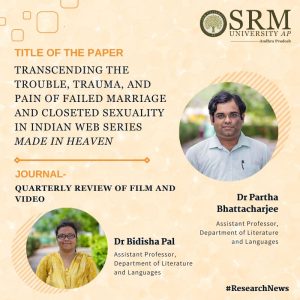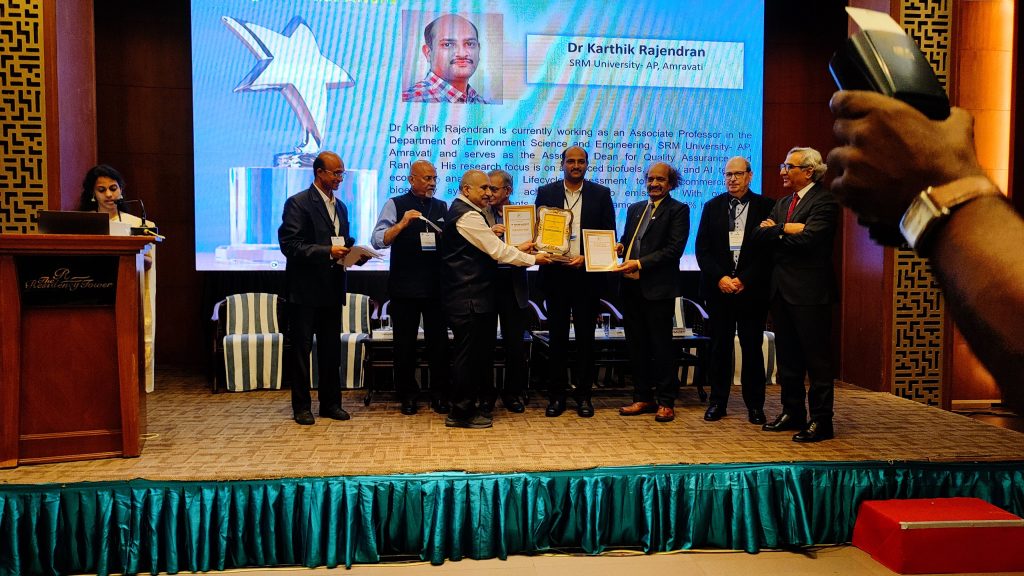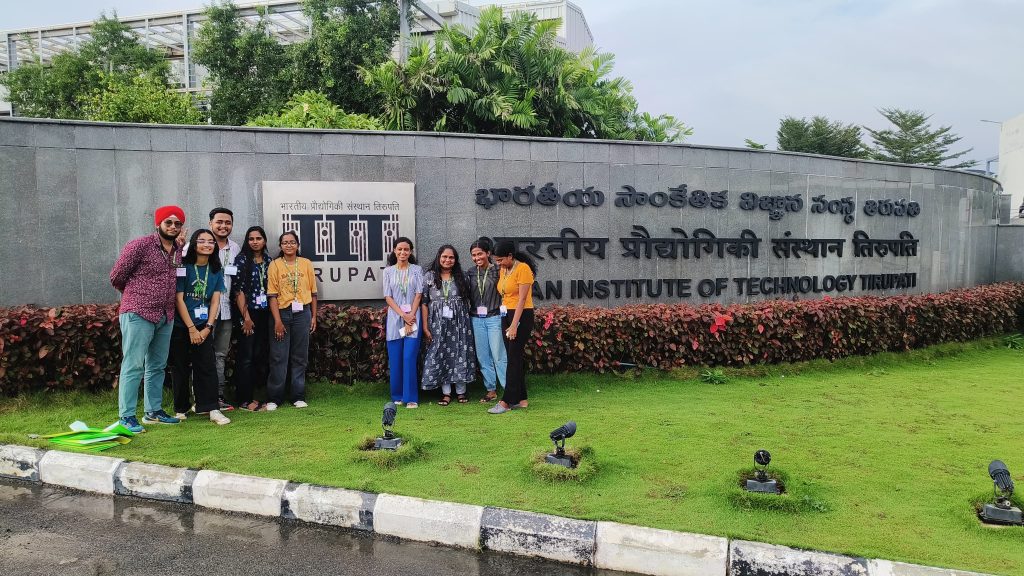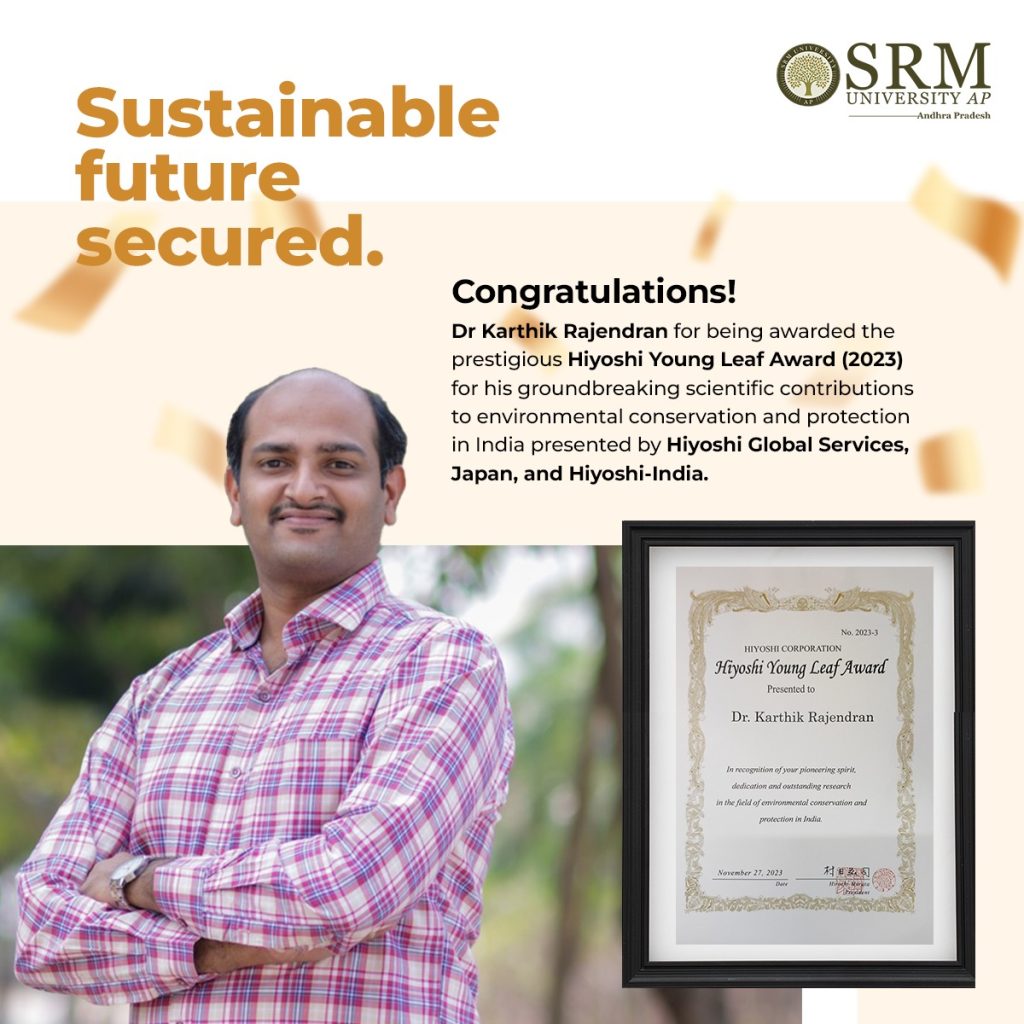Scholarly Exploration into Nuanced Portrayal of Human Experiences
 Dive into the realms of contemporary literature as our esteemed faculty members, Dr Partha Bhattacharjee and Dr Bidisha Pal from the Department of Literature and Languages presented their latest research endeavor. Their collaborative paper, titled “Transcending the Trouble, Trauma, and Pain of Failed Marriage and Closeted Sexuality in Indian Web Series Made in Heaven,” has found its home in the prestigious journal “Quarterly Review of Film and Video” (Scopus Q2).This scholarly exploration take into the portrayal of human experiences in the context of failed relationships and concealed identities within the framework of Indian web series. Join us in celebrating their insightful contributions to the literary discourse, reflecting SRM AP’s commitment to advancing knowledge and fostering academic excellence.
Dive into the realms of contemporary literature as our esteemed faculty members, Dr Partha Bhattacharjee and Dr Bidisha Pal from the Department of Literature and Languages presented their latest research endeavor. Their collaborative paper, titled “Transcending the Trouble, Trauma, and Pain of Failed Marriage and Closeted Sexuality in Indian Web Series Made in Heaven,” has found its home in the prestigious journal “Quarterly Review of Film and Video” (Scopus Q2).This scholarly exploration take into the portrayal of human experiences in the context of failed relationships and concealed identities within the framework of Indian web series. Join us in celebrating their insightful contributions to the literary discourse, reflecting SRM AP’s commitment to advancing knowledge and fostering academic excellence.
Abstract
Premiered as a television web series on Amazon Prime Video on 8th March 2019, Made in Heaven (2019) simultaneously unmasks the hypocrisies and lies of the big fat Indian weddings and breaks the taboo of homosexuality. In consecutive nine episodes, the plots and the subplots are beaded together to initiate a sensory sensitization towards the hypocrisy of marriages and insensitive homophobia. Carefully analyzing postulates from theorists this short article attempts to decode the trouble, trauma, and pain encoded in messy lifestyles, marriages, and relationships characterizing and wielding the lives as well as the sexuality of the characters in the web series
Explanation in Layperson’s Terms
The research revolves around the concept of marriage in Indian society as well as homosexuality in the Indian Hindi web series Made in Heaven (2019). The research shows how the various episodes of the web series showcase different aspects of marriage and the actual reality behind the pomp and pleasure of high-profile weddings within society. On the other hand sexuality and sexual desire are often hidden and do not get proper channelization in a person’s life. The desire thus remains suppressed and results in crisis in many forms. There are other intertwined concerns such as the dowry system, social disparity, impotency, virginity, and sexual molestations which weave a meta-narrative on the popular medium and raise consciousness regarding how people should react to those hazards and behave accordingly.
Practical Implementation and Social Implications of the Research
The research involves practical aspects such as the dowry system, social disparity, impotency, virginity, and sexual molestations which are part of our social lives. Many people have to face such things in their day-to-day lives. This research brings out such realities of society while analyzing the mental condition and psychology behind these. Moreover, this research also shows marriage is an important decision in a person’s life, it should be made in terms of love and respect, not based upon money and social status. The research visits practical examples and revisits the laws to substantiate the arguments. Popular media such as web series is not just a form of entertainment, but it can be a medium for building awareness.
- Published in English Current Happenings, News, Research News
Dr Karthik Rajendran Honoured with Young Scientist Award

Dr Karthik Rajendran, Associate Professor, Department of Environmental Science & Engineering has been conferred with the Young Scientist Award from the Biotechnology Society of India. The award was received by Dr Karthik Rajendran from Padmashree Prof. GD Yadav (ICT Mumbai).
This prestigious award is given to scientists less than 35 years old for their work carried out in India. This is a testament to the work he has been doing at SRM University-AP for the last 4.5 years. The Jury of the award committee consisted of twenty-three experts across India and the Globe.
In the last 20 years of its inception, only once before such an award was given to any private institution.
- Published in Departmental News, ENVS News, News
MSc Environmental Science Students Attend Workshop on Sustainable Wastewater Management

MSc Students from the Department of Environmental Science and Engineering had a delightful opportunity to participate in the Workshop on “Sustainable Wastewater Management: The Role of Advanced Treatment and Sensing Technologies” organised by the Department of Civil and Environmental Engineering, Indian Institute of Technology Tirupati on December 01 and 02, 2023. The students got to learn about novel technologies available for wastewater treatment and also visited three wastewater treatment plants at IIT Tirupati that showcased wastewater recycling technologies. Fruitful discussions with both academicians and industrial experts on current challenges in wastewater management and innovations and opportunities in the water sector were the highlights of the workshop.
- Published in Departmental News, ENVS News, News
Dr Karthik Rajendran Receives Hiyoshi Young Leaf Award

A proud moment for SRM University-AP as Dr Karthik Rajendran, Associate Professor in the Department of Environmental Science and Engineering, receives the prestigious Hiyoshi Young Leaf Award.
The Hiyoshi Young Leaf Award recognises novel, innovative, and outstanding scientific research and application in the field of environmental conservation and protection in India. Dr Rajendran’s dedication to research, innovative approaches, and impact on the academic community have earned him this esteemed accolade.
“We extend our heartfelt congratulations to Dr Karthik Rajendran for this well-deserved recognition,” said Prof. Manoj K Arora, Vice Chancellor, SRM University-AP. “His exemplary work reflects the varsity’s commitment to fostering excellence in the field of Environmental Science and Engineering.”
“It is a great honour to be receiving the Hyoshi Young Leaf Award, it motivates me further to work harder and with greater passion, I would like to thank Hiyoshi Corporation for presenting me with this award,” said Dr Karthik Rajendran.
Dr Rajendran has received several awards in the past for his remarkable contributions to the field of environmental science and engineering. He has been recognised as one of the top 2% of scientists by Stanford University and has also been honoured with the Young Scientist Award among others. Apart from his research, Dr Rajendran is also dedicated to educating the next generation of environmental scientists and engineers, thereby playing a crucial role in shaping future leaders in the field.
SRM University-AP celebrates this milestone in Dr Rajendran’s career and looks forward to continued excellence in his contributions to environmental science.
- Published in ENVS News, Faculty Achievements, News

